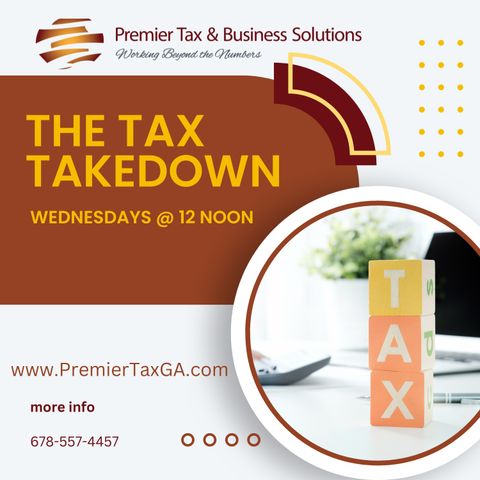www.PremierTaxGA.com Hello, everyone, and welcome to another episode of The Tax Takedown, brought to you by Premier Tax & Business Solutions. I'm your host, Carla Nash, and today we're diving deep into a topic that's often overlooked but critical for businesses of all sizes - Inventory Management and Valuation. Inventory, folks, it's the lifeblood of many businesses. Whether you're a retail giant or a small mom-and-pop store, effectively managing and valuing your inventory is crucial for financial success and tax compliance. So, let's break it down. First, let's talk about why inventory management matters. Properly handling your inventory can improve your cash flow, reduce storage costs, and help you identify trends and optimize your product offerings. Plus, when it comes to taxes, your inventory valuation can significantly impact your taxable income. So, how do you manage your inventory effectively? Well, it all starts with organization. Whether you use a digital system or the tried-and-true method of pen and paper, keeping track of what you have, how much it costs, and how quickly it moves is key. For many businesses, adopting inventory management software can be a game-changer. These tools help automate data entry, track sales trends, and alert you when it's time to reorder. It's like having a personal assistant for your inventory. Now, let's get into inventory valuation. There are a few methods to choose from, and the one you use can affect your tax liability. The most common methods are FIFO (First-In, First-Out), LIFO (Last-In, First-Out), and Weighted Average Cost. FIFO assumes that the oldest items in your inventory are sold first, while LIFO assumes the newest items are sold first. Weighted Average Cost takes the average cost of all items in your inventory. Each method has its pros and cons, so it's essential to consult with a tax professional to determine which one aligns best with your business goals and the tax laws in your jurisdiction. When it comes to taxes, the IRS generally requires businesses to use the same valuation method for both their financial statements and tax returns. This consistency ensures accuracy and transparency. But remember, rules can vary by country, so be sure to consult with a tax expert who knows the local regulations. Finally, let's discuss the impact of inventory valuation on your taxable income. FIFO tends to result in lower taxable income when prices are rising, while LIFO can reduce taxable income when prices are falling. Weighted Average Cost often falls somewhere in between. But here's a crucial tip: if you're using LIFO, you may have to maintain a reserve to cover potential tax liabilities when you eventually sell the older, lower-cost inventory. This can be complex, so it's vital to work with tax professionals who specialize in inventory valuation methods. In conclusion, my fellow business owners and entrepreneurs, inventory management and valuation are not topics to be taken lightly. They impact your bottom line, your taxes, and your overall business health. So, make sure you have a solid strategy in place and consult with experts when needed. Thank you for joining me today on The Tax Takedown, brought to you by Premier Tax & Business Solutions. If you have any questions or need further assistance with inventory management and valuation, don't hesitate to reach out to our team. Until next time, stay savvy, stay organized, and stay profitable.
mostra meno

